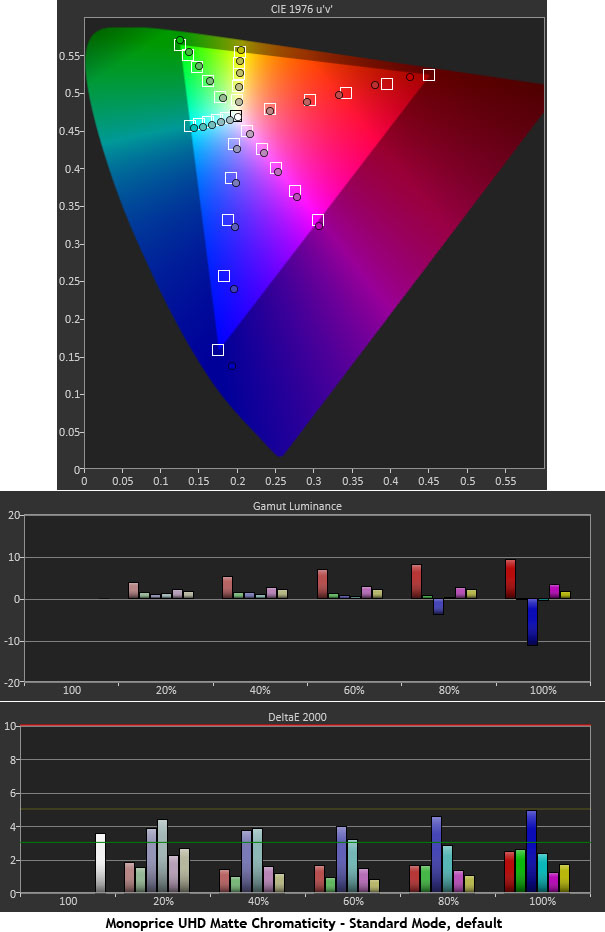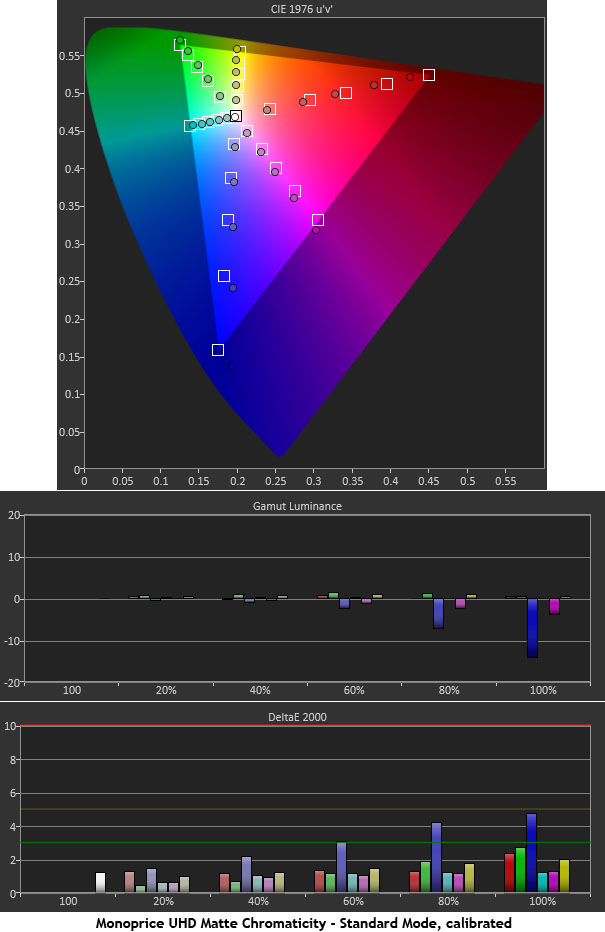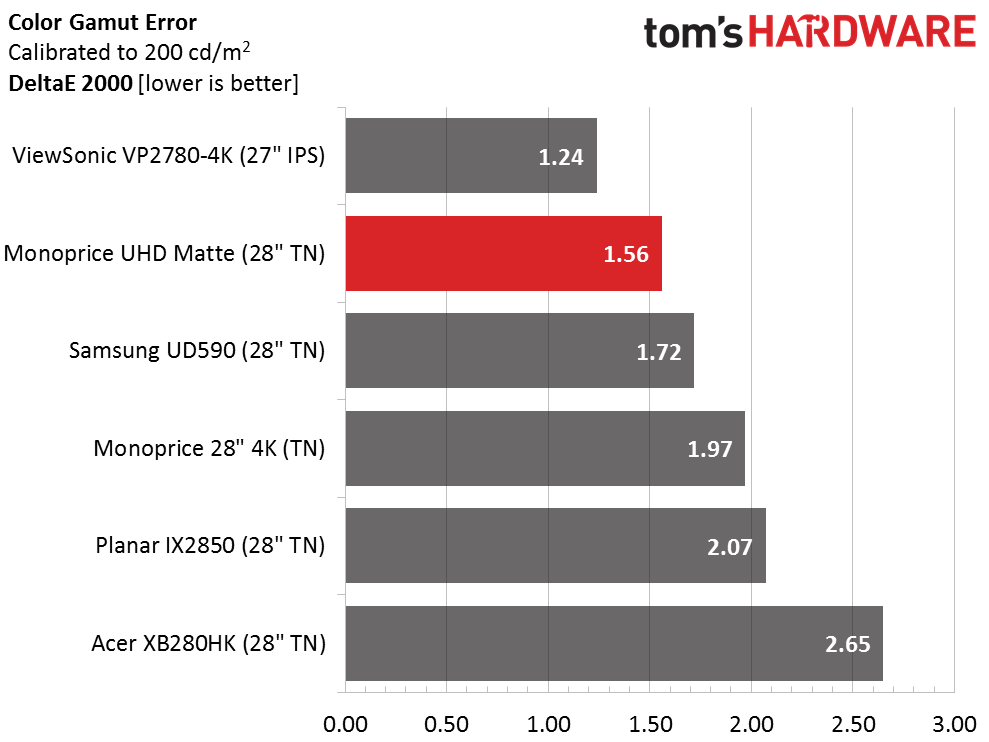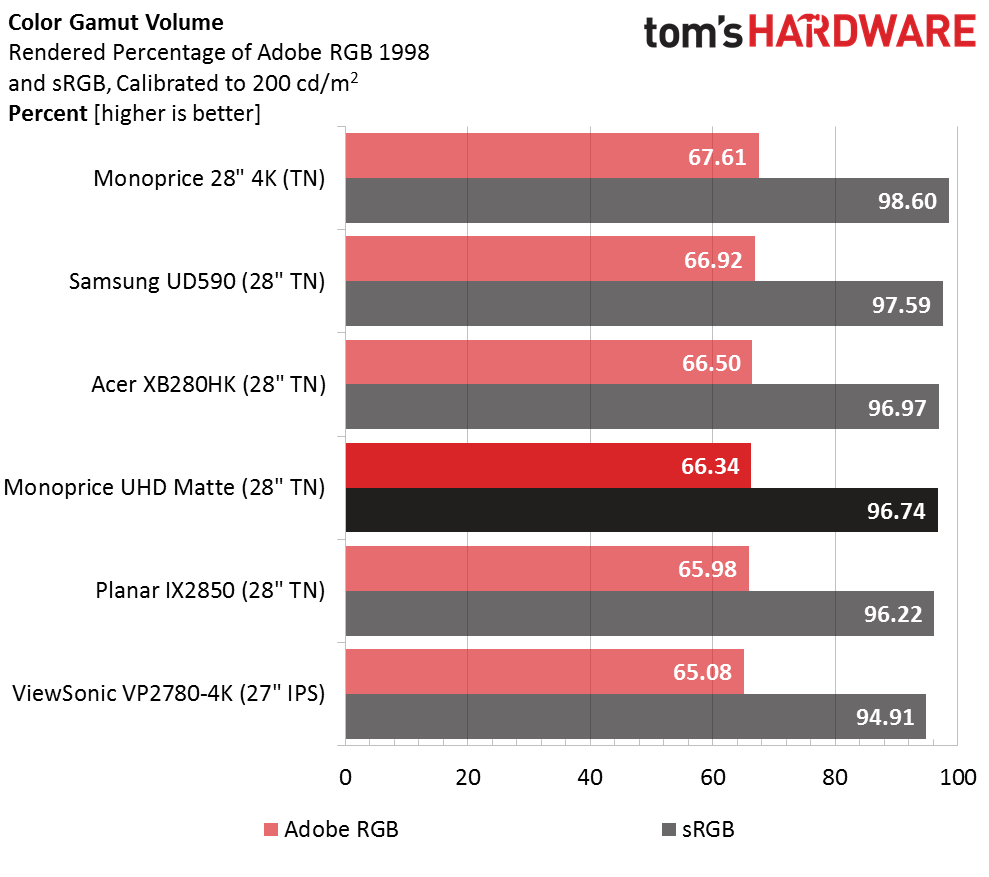Monoprice UHD Matte 28-inch Monitor Review
Monoprice's new 28-inch Ultra HD monitor features an anti-glare layer, which offers great viewing angles. But can the new UHD match the performance to the company's CrystalPro 4k display?
Why you can trust Tom's Hardware
Color Gamut & Performance
For details on our color gamut testing and volume calculations, please click here.
The green/cyan/yellow side of the gamut triangle is pretty much dead-on with regards to saturation and hue. There are some small errors on the blue/magenta/red end however. Blue trends toward over-saturation as levels increase and red is a bit under. Luminance levels have been adjusted to compensate however, so the resulting error is quite small. The pre-calibration average is 2.4dE.
Calibration drops the error to 1.56dE but the saturation anomalies in red and blue remain. You might be tempted to adjust the hue or saturation controls to fix this but the other colors would then be affected. Since luminance levels are properly set to offset the saturation errors, there is little about the UHD Matte's color that's truly off the mark. It's better than we'd expect from a $350 Ultra HD monitor.
Now we return to the comparison group.
In the Ultra HD category you'll have to spend a lot more money to exceed the color accuracy of any of these displays. Even though they're budget models with TN panels, none of them have significant chromaticity errors. The UHD Matte's accuracy is more than adequate for any use other than color-critical applications.
Gamut Volume: Adobe RGB 1998 And sRGB
Gamut volume is reduced a little by under-saturation in the red primary. And the bonus blue isn't quite enough to make up for it. Since luminance levels are properly compensated we can't see any color errors but in a high-end graphics workstation you'll want a monitor that can reproduce a full 100 percent sRGB gamut.
Get Tom's Hardware's best news and in-depth reviews, straight to your inbox.
Current page: Color Gamut & Performance
Prev Page Grayscale Tracking & Gamma Response Next Page Viewing Angles, Uniformity, Response & Lag
Christian Eberle is a Contributing Editor for Tom's Hardware US. He's a veteran reviewer of A/V equipment, specializing in monitors. Christian began his obsession with tech when he built his first PC in 1991, a 286 running DOS 3.0 at a blazing 12MHz. In 2006, he undertook training from the Imaging Science Foundation in video calibration and testing and thus started a passion for precise imaging that persists to this day. He is also a professional musician with a degree from the New England Conservatory as a classical bassoonist which he used to good effect as a performer with the West Point Army Band from 1987 to 2013. He enjoys watching movies and listening to high-end audio in his custom-built home theater and can be seen riding trails near his home on a race-ready ICE VTX recumbent trike. Christian enjoys the endless summer in Florida where he lives with his wife and Chihuahua and plays with orchestras around the state.
-
jragonsoul Replyi wish the display was bigger, 40-50 inch, at 28 i find it useless.
Then you should get a television unless you want to pay 2000+ USD for the monitor. -
g-unit1111 What's the cost? For someone who is in the market for a new monitor this is an interesting option.Reply -
bit_user Reply
I don't know about 50" (unless you're sitting like 5 feet away), but 4k resolution at 28" seems a waste, to me. My 27" is 2560x1440 and I think I'd probably have to go up to at least 32" for my eyes to make out much more detail.17501375 said:i wish the display was bigger, 40-50 inch, at 28 i find it useless.
But I'm waiting for the next generation of GPUs, before I even start thinking about 4k monitors. Ideally, I'd wait until I can get a 14/16 nm GPU with HBM2 for <= $250.
-
Nintendork The monitor is pretty <removed>, when smartphone screens are reaching 2000:1 using the IPS panels with "quantum dot" you ask yourself why should you buy a crappy pc monitor.Reply
Watch the language. - G -
jragonsoul Reply
Honestly I think HBM2 is going to be reserved for higher tier GPUS (I HOPE I AM WRONG!) so I'm thinking bare minimum would be 300-350 for one. Would be glad to be proven wrong though.17503284 said:
I don't know about 50" (unless you're sitting like 5 feet away), but 4k resolution at 28" seems a waste, to me. My 27" is 2560x1440 and I think I'd probably have to go up to at least 32" for my eyes to make out much more detail.17501375 said:i wish the display was bigger, 40-50 inch, at 28 i find it useless.
But I'm waiting for the next generation of GPUs, before I even start thinking about 4k monitors. Ideally, I'd wait until I can get a 14/16 nm GPU with HBM2 for <= $250.
-
hannibal I also have 27" 2560x1440, and also think that the sweet spot for 4K is near 32". But hard to say without testing it personally.Reply
But in reality 4K needs G-sync or Freesync IMHO, because how much it needs horsepower to run in. Frame rates are not going to be great with these for many years.
-
sc14s ReplyThe monitor is pretty <removed>, when smartphone screens are reaching 2000:1 using the IPS panels with "quantum dot" you ask yourself why should you buy a crappy pc monitor.
You are comparing the monitor to something that probably costs somewhere around double if you are going high end phone (which you would have to have for high end screens). This isn't even mentioning the fact that you are getting a fraction of the viewing size on the phone. Apples to oranges really.
Watch the language. - G



